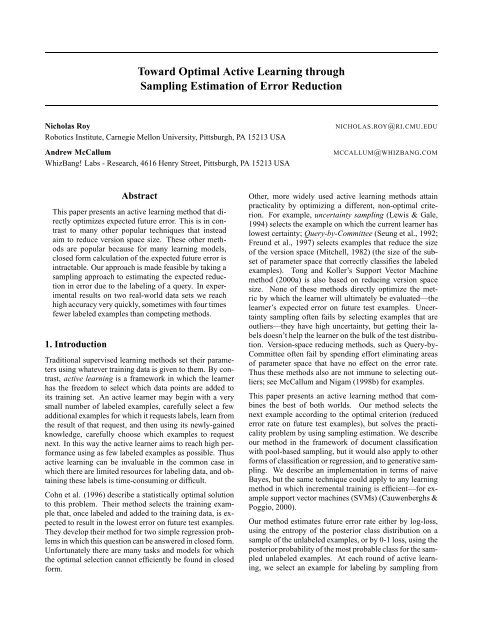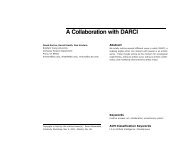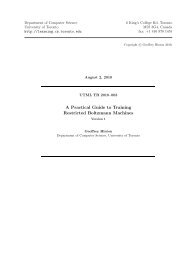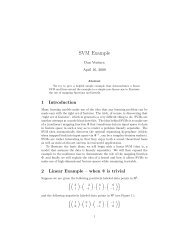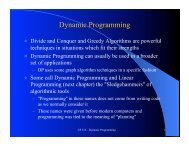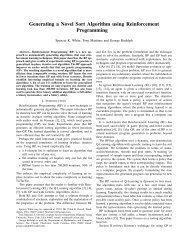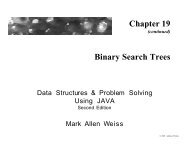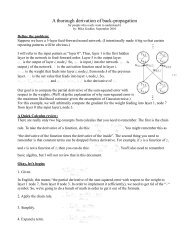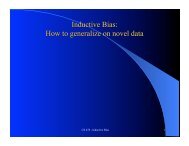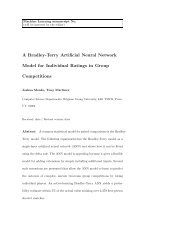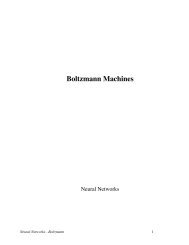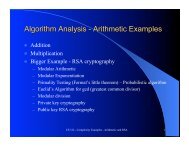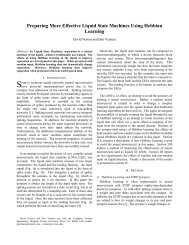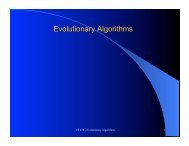Toward Optimal Active Learning through Sampling ... - CiteSeerX
Toward Optimal Active Learning through Sampling ... - CiteSeerX
Toward Optimal Active Learning through Sampling ... - CiteSeerX
You also want an ePaper? Increase the reach of your titles
YUMPU automatically turns print PDFs into web optimized ePapers that Google loves.
<strong>Toward</strong> <strong>Optimal</strong> <strong>Active</strong> <strong>Learning</strong> <strong>through</strong><br />
<strong>Sampling</strong> Estimation of Error Reduction<br />
Nicholas Roy<br />
Robotics Institute, Carnegie Mellon University, Pittsburgh, PA 15213 USA<br />
Andrew McCallum<br />
WhizBang! Labs - Research, 4616 Henry Street, Pittsburgh, PA 15213 USA<br />
NICHOLAS.ROY@RI.CMU.EDU<br />
MCCALLUM@WHIZBANG.COM<br />
Abstract<br />
This paper presents an active learning method that directly<br />
optimizes expected future error. This is in contrast<br />
to many other popular techniques that instead<br />
aim to reduce version space size. These other methods<br />
are popular because for many learning models,<br />
closed form calculation of the expected future error is<br />
intractable. Our approach is made feasible by taking a<br />
sampling approach to estimating the expected reduction<br />
in error due to the labeling of a query. In experimental<br />
results on two real-world data sets we reach<br />
high accuracy very quickly, sometimes with four times<br />
fewer labeled examples than competing methods.<br />
1. Introduction<br />
Traditional supervised learning methods set their parameters<br />
using whatever training data is given to them. By contrast,<br />
active learning is a framework in which the learner<br />
has the freedom to select which data points are added to<br />
its training set. An active learner may begin with a very<br />
small number of labeled examples, carefully select a few<br />
additional examples for which it requests labels, learn from<br />
the result of that request, and then using its newly-gained<br />
knowledge, carefully choose which examples to request<br />
next. In this way the active learner aims to reach high performance<br />
using as few labeled examples as possible. Thus<br />
active learning can be invaluable in the common case in<br />
which there are limited resources for labeling data, and obtaining<br />
these labels is time-consuming or difficult.<br />
Cohn et al. (1996) describe a statistically optimal solution<br />
to this problem. Their method selects the training example<br />
that, once labeled and added to the training data, is expected<br />
to result in the lowest error on future test examples.<br />
They develop their method for two simple regression problems<br />
in which this question can be answered in closed form.<br />
Unfortunately there are many tasks and models for which<br />
the optimal selection cannot efficiently be found in closed<br />
form.<br />
Other, more widely used active learning methods attain<br />
practicality by optimizing a different, non-optimal criterion.<br />
For example, uncertainty sampling (Lewis & Gale,<br />
1994) selects the example on which the current learner has<br />
lowest certainty; Query-by-Committee (Seung et al., 1992;<br />
Freund et al., 1997) selects examples that reduce the size<br />
of the version space (Mitchell, 1982) (the size of the subset<br />
of parameter space that correctly classifies the labeled<br />
examples). Tong and Koller’s Support Vector Machine<br />
method (2000a) is also based on reducing version space<br />
size. None of these methods directly optimize the metric<br />
by which the learner will ultimately be evaluated—the<br />
learner’s expected error on future test examples. Uncertainty<br />
sampling often fails by selecting examples that are<br />
outliers—they have high uncertainty, but getting their labels<br />
doesn’t help the learner on the bulk of the test distribution.<br />
Version-space reducing methods, such as Query-by-<br />
Committee often fail by spending effort eliminating areas<br />
of parameter space that have no effect on the error rate.<br />
Thus these methods also are not immune to selecting outliers;<br />
see McCallum and Nigam (1998b) for examples.<br />
This paper presents an active learning method that combines<br />
the best of both worlds. Our method selects the<br />
next example according to the optimal criterion (reduced<br />
error rate on future test examples), but solves the practicality<br />
problem by using sampling estimation. We describe<br />
our method in the framework of document classification<br />
with pool-based sampling, but it would also apply to other<br />
forms of classification or regression, and to generative sampling.<br />
We describe an implementation in terms of naive<br />
Bayes, but the same technique could apply to any learning<br />
method in which incremental training is efficient—for example<br />
support vector machines (SVMs) (Cauwenberghs &<br />
Poggio, 2000).<br />
Our method estimates future error rate either by log-loss,<br />
using the entropy of the posterior class distribution on a<br />
sample of the unlabeled examples, or by 0-1 loss, using the<br />
posterior probability of the most probable class for the sampled<br />
unlabeled examples. At each round of active learning,<br />
we select an example for labeling by sampling from
e<br />
e<br />
the unlabeled examples, adding it to the training set with a<br />
sample of its possible labels, and estimating the resulting<br />
future error rate as just described. This seemingly daunting<br />
sampling and re-training can be made efficient <strong>through</strong><br />
a number of rearrangements of computation, careful sampling<br />
choices, and efficient incremental training procedures<br />
for the underlying learner.<br />
We show experimental results on two real-world document<br />
classification tasks, where, in comparison with densityweighted<br />
Query-by-Committee we reach 85% of full performance<br />
in one-quarter the number of training examples.<br />
mate it using the current learner. 1 (For log loss this results<br />
in estimating the error by the entropy of the learner’s posterior<br />
distribution).<br />
Writing the documentsdT labeled<br />
Q, for log<br />
loss we have<br />
¡§Q£Q¨as<br />
and for 0/1 loss<br />
(3) ) C ¥c ¥f -9Lg f 7U9: @ \¡£¥§©¨=?¡@ \¡£¥§¨¨N &'\ #4$<br />
2. <strong>Optimal</strong> <strong>Active</strong> <strong>Learning</strong> and <strong>Sampling</strong><br />
Estimation<br />
The optimal active learner is one that asks for labels on the<br />
examples that, once incorporated into training, will result<br />
in the lowest expected error on the test set.<br />
be<br />
Let<br />
inputs,§,<br />
¢¡§¨be<br />
and output classes,££££©,and<br />
let<br />
¢¡¤£¦¥§©¨<br />
an unknown conditional distribution over<br />
the marginal “input” distribution. The learner<br />
is given a set, labeled training<br />
¢¡£¥§©¨,and<br />
, consisting of IID input/output<br />
pairs drawn from estimates a<br />
classification function that, given an input§, produces an<br />
"¡£¥§©¨. estimated output We can then write<br />
the expected error of the learner as follows:<br />
¢¡§¨<br />
distribution!<br />
is some loss function that measures the degree<br />
of our disappointment in any differences between the true<br />
¢¡£¥§¨and ¡¤£¥§¨.<br />
where.<br />
prediction, distribution, the learner’s<br />
Two common loss functions are:<br />
log<br />
and 0/1 A¡¤£¥§¨¨ ¢¡£¥§©¨=?¡@ loss:.4)65879:<br />
(1)<br />
¡0 ¢¡£¥§©¨1 ! "¡£¥§©¨2¨3 ¢¡§¨1 &('*),+-/. #%$<br />
"¡£OP¥§©¨2¨.<br />
First-order Markov active learning thus aims to select a<br />
query,§RQ, such that when the query is given and<br />
.B),5879: @ ¢¡£¥§©¨¡CEDGF¡£2HI2?3J¢HLK7NM¤9:<br />
label£SQ<br />
added to the<br />
¡§RQ
©<br />
5 ¦<br />
¡77¨719:<br />
<br />
,<br />
@/<br />
@<br />
# @<br />
<br />
" ¢¡¥<br />
-$<br />
# @<br />
<br />
# @<br />
<br />
some rearrangements of computation, there are a number<br />
of optimizations and approximations that make this algorithm<br />
much more efficient and very tractable:<br />
Most importantly, many learning algorithms have algorithms<br />
for very efficient incremental training. That is,<br />
the cost of re-training after adding one more example to<br />
the training set is far less than re-training as if the entire<br />
set were new. For example, in a naive Bayes classifier,<br />
only a few event counts need be incremented. SVMs also<br />
have efficient re-training procedures (Cauwenberghs &<br />
Poggio, 2000).<br />
Furthermore, many learners have efficient algorithms for<br />
incremental re-classification of the examples in the pool.<br />
In incremental re-classification, the only parts of computation<br />
that need to be redone are those that would have<br />
changed as a result of the additional training instance.<br />
Again, naive Bayes and SVMs are two examples of algorithms<br />
that permit this.<br />
After adding a candidate query to the training set, we do<br />
not need to re-estimate the error associated with all other<br />
examples in the pool—only those likely to be effected<br />
by the inclusion of the candidate in the training set. In<br />
many cases this means simply skipping examples not in<br />
the “neighborhood” of the candidate or skipping examples<br />
without any features that overlap with the features<br />
of the candidate. Inverted indices, in which all the examples<br />
containing a particular features are listed together,<br />
can make this extremely efficient.<br />
The pool of candidate queries can be reduced by random<br />
sub-sampling, or pre-filtering to remove outliers according<br />
to some criteria. In fact, any of the suboptimal active<br />
learning methods might make good pre-filters.<br />
The expected error can be estimated using only a subsample<br />
of the pool. Especially when the pool is large,<br />
there is no need to use all examples—a good estimate<br />
may be formed with only few hundred examples.<br />
In the remainder of the paper we describe a naive Bayes<br />
implementation of our method, discuss related work, and<br />
present experimental results on two real-world data sets<br />
showing that our method significantly outperforms methods<br />
optimize indirect criteria, such as query uncertainty.<br />
We also outline some future work.<br />
When little training data is being used to estimate the parameters<br />
for a large number of features, it is often best to<br />
use a simple learning model. In such cases, there is not<br />
enough data to support estimations of feature correlations<br />
and other complex interactions. One such classification<br />
method that performs surprisingly well given its simplicity<br />
is naive Bayes. Naive Bayes is not always the best performing<br />
classification algorithm for text (Nigam et al., 1999;<br />
Joachims, 1998), but it continues to be widely used for the<br />
purpose because it is efficient and simple to implement, and<br />
even against significantly more complex methods, it rarely<br />
trails far behind in accuracy.<br />
This paper’s sampling approach to active learning could be<br />
applied to several different learners. We apply it here to<br />
naive Bayes for the sake of simplicity of explanation and<br />
implementation. Experiments with other learners is an item<br />
of future work.<br />
Naive Bayes is a Bayesian classifier based on a generative<br />
model in which data are produced by first<br />
class,£<br />
selecting<br />
a , and then generating features of the instance,§<br />
,<br />
¢¡<br />
independently given the class. For text<br />
classification, the common variant of naive Bayes has unordered<br />
word counts for features, and uses a per-class<br />
¤£<br />
multinomial to generate the words (McCallum & Nigam,<br />
¥§¦ 1998a). Let ¨ be the th word in the dictionary of words<br />
, 9 and be the parameters of<br />
the model, where¢¡£¥¨), is the prior probability of class£<br />
7<br />
(otherwise written and 7 where is the probability<br />
of generating ¥ ¦ word from the multinomial associated<br />
class£<br />
with (otherwise written ¦¥£¨, and<br />
)<br />
¢¡¥<br />
for 7 all£<br />
.<br />
C )<br />
Thus the probability of generating the th instance,§<br />
¢¡¤§¥¨<br />
:<br />
f<br />
-!<br />
rule, the probability document§<br />
that<br />
is class£<br />
¢¡£(¥¨<br />
@<br />
# is the ' th word in document§<br />
where§<br />
is<br />
(5)<br />
&%¥£¨N<br />
. Then, by Bayes<br />
was generated by<br />
(6)<br />
¢¡¥ ¢¡¥ -&%¥£,¨ +%¥£¨ -<br />
3. Naive Bayes Text Classification<br />
Text classification is not only a task of tremendous practical<br />
significance, but is also an interesting problem in machine<br />
learning because it involves an unusually large number of<br />
features, and thus requires estimating an unusually large<br />
number of parameters. It is also a domain in which obtaining<br />
labeled data is expensive, since the human effort<br />
of reading and assigning documents to categories is almost<br />
always required. Hence, the large number of parameters<br />
often must be estimated from a small amount of labeled<br />
data.<br />
)<br />
¢¡£(¥¨()*-<br />
Maximum a posteriori parameter estimation is performed<br />
by taking ratios of counts:<br />
¢¡£¥§(2¨<br />
(7 ) <br />
<br />
0<br />
<br />
5 C<br />
@5 T5 <br />
¡¥§¦2§¨is<br />
¥©"¥T<br />
¢¡£(¥§¨is<br />
the<br />
, and<br />
5 C T<br />
¡¥<br />
/<br />
<br />
(7) ¡¥ 02§¨ ¢¡£
c ,<br />
0<br />
)<br />
@/<br />
3.1 Fast Naive Bayes Updates<br />
Equations (3) and (4) show how the pool of unlabeled documents<br />
can be used to estimate the change in classifier error<br />
if we label one document. However, in order to choose<br />
the best candidate from the pool of unlabeled documents<br />
we have to classifier¥c train the<br />
¥times, and<br />
classify¥c<br />
each time<br />
documents. Performing<br />
¥¨classifications<br />
for every query can be computationally infeasible<br />
for large document pools.<br />
¡2¥c ¥tD8C<br />
While we cannot reduce the total number of classifications<br />
for every query, we can take advantage of certain data structures<br />
in a naive Bayes classifier to allow more efficient retraining<br />
of the classifier and relabeling of each unlabeled<br />
document.<br />
Recall from equation (6) that each class probability for an<br />
unlabeled document is a product of the word probabilities<br />
for that label. When we compute the class probabilities<br />
for each unlabeled document using the new classifier, we<br />
make an approximation by only modifying some of the<br />
word probabilities in the product of equation (6). By propagating<br />
only changes to word probabilities for words in the<br />
putatively labeled document, we gain substantial computational<br />
savings compared to retraining and reclassifying<br />
each document.<br />
Given a classifier learned from data training , we can add<br />
a document§¢¡<br />
new label££¡<br />
with to the training data and<br />
update the class probabilities (for class£ ¡<br />
that ) of each unlabeled<br />
document§<br />
inc by:<br />
¨-)<br />
9-$ O0¡¥ ) ¢¡¤£ ¡¥§2 ¥¤
“Selective <strong>Sampling</strong>”), in which unlabeled data is presented<br />
to the learner from some distribution, and the learner<br />
chooses queries from this sample (either as a pool or a<br />
stream). From this data-oriented perspective, Lewis and<br />
Gale (1994) presented the uncertainty sampling algorithm<br />
for choosing the example with the greatest uncertainty in<br />
predicted label. Freund et al. (1997) showed that uncertainty<br />
sampling does not converge to the optimal classifier<br />
as quickly as the “Query-By-Committee” algorithm (Seung<br />
et al., 1992).<br />
In the “Query By Committee” (QBC) approach, the method<br />
is to reduce the error of the learner by choosing the instance<br />
to be labeled that will minimize the size of the version<br />
space (Mitchell, 1982) consistent with the labeled examples.<br />
Instead of explicitly determining the size of the<br />
version space, predicted labels for each unlabeled example<br />
are generated by first drawing hypotheses probabilistically<br />
from the version space, according to a distribution<br />
over the concepts in the version space. These hypotheses<br />
are then used to predict the example label. Examples arrive<br />
from a stream, and are labeled whenever the ‘committee’<br />
of hypotheses disagree on the predicted label. This approach<br />
chooses examples that “split the version space into<br />
two parts of comparable size” with a degree of probability<br />
that guarantees data efficiency that is logarithmic in the<br />
desired probability of error.<br />
A number of others have made use of QBC-style algorithms;<br />
in particular, Liere and Tadepalli (1997) use committees<br />
of Winnow learners for text classification, and<br />
Argamon-Engelson and Dagan (1999) use QBC for natural<br />
language processing. Our algorithm differs from theirs<br />
in that we are estimating the error reduction, whereas Argamon<br />
et al. are simply estimating the example disagreement.<br />
They also point out that committee-based selection can be<br />
viewed as a Monte Carlo method for estimating label distributions<br />
over all possible models, given the labeled data.<br />
Abe and Mamitsuka (1998) use a bagging and boosting approach<br />
for maximizing the classifier accuracy on the test<br />
data. This approach suggests that by maximizing the margin<br />
on training data, accuracy on test data is improved, an<br />
approach that is not always successful (Grove & Schuurmans,<br />
1998). Furthermore, like the QBC algorithms before<br />
it, the QBC-by-boosting approach fails to maximize<br />
the margin on all unlabeled data, instead choosing to query<br />
the single instance with the smallest margin.<br />
McCallum and Nigam (1998b) extend the earlier QBC approach<br />
by not only using pool-based QBC, but also using<br />
a novel disagreement metric. Whereas the streambased<br />
approaches classify whenever a level of disagreement<br />
(possibly any) occurs, in pool-based QBC, the best<br />
unlabeled example is chosen. Argamon-Engelson and Dagan<br />
(1999) suggest using a probabilistic measure based<br />
on vote-entropy of the committee, whereas McCallum &<br />
Nigam explicitly measure disagreement using the Jensen-<br />
Shannon divergence (Lin, 1991; Pereira et al., 1993). However,<br />
they recognize that this error metric does not measure<br />
the impact that a labeled document had on classifier uncertainty<br />
on other unlabeled documents. They therefore<br />
factored document density into their error metric, to decrease<br />
the likelihood of uncertain documents that are outliers.<br />
Nevertheless, document density is a rough heuristic<br />
that is specific to text classification, and does not directly<br />
measure the impact of a document’s label on other<br />
predicted labelings.<br />
More recently, Tong and Koller (2000a) use active learning<br />
with Support Vector Machines for text classification. Their<br />
SVM approach reduces classifier uncertainty by estimating<br />
the reduction in version space size as a function of querying<br />
instances. Thus, like QBC, they explicitly reduce version<br />
space size, implicitly reducing future expected error. The<br />
active learning technique they propose also makes strong<br />
assumptions about the linear separability of the data.<br />
Similar in approach to our work, Lindenbaum et al. (1999)<br />
examine active learning by minimizing the expected error<br />
using nearest neighbor classifiers. Their approach is very<br />
similar to ours with respect to loss function; the maximization<br />
of expected utility is exactly equivalent to our minimization<br />
of error with a 0/1 loss function. However, they<br />
do not smooth label distributions by using bagging.<br />
Tong and Koller (2000b) describe a method of active learning<br />
for learning the parameters of Bayes nets. Their “expected<br />
posterior risk” is very similar to our expected error<br />
as in equation (1). However, they use a slightly different<br />
loss function and average the loss over the possible models,<br />
as opposed to estimating the loss of the maximum a posteriori<br />
distribution itself. Their method emphasizes learning<br />
a good joint distribution over the instance space, which<br />
has the advantage of creating better generative models, but<br />
may not necessarily lead to the most useful queries for a<br />
discriminative model.<br />
5. Experimental Results<br />
NEWSGROUP DOMAIN<br />
The first set of experiments used Ken Lang’s Newsgroups,<br />
containing 20,000 articles evenly divided among<br />
20 UseNet discussion groups (McCallum & Nigam,<br />
1998b). We performed two experiments to perform binary<br />
classification. The first experiment used the two classes<br />
comp.graphics and comp.windows.x. The data<br />
was pre-processed to remove UseNet headers and UUencoded<br />
binary data. Words were formed from contiguous<br />
sequences of alphabetic characters. Additionally, words<br />
were removed if they are in a stoplist of common words,<br />
or if they appear in fewer than 3 documents. As in Mc-<br />
Callum and Nigam (1998b), no feature selection or stemming<br />
was performed. The resulting vocabulary had 10,205<br />
words. All results reported are the average of 10 trials. The
data set of 2000 documents was split into a training set of<br />
1000 documents, and 1000 test documents.<br />
We tested 4 different active learning algorithms:<br />
Random – choosing the query document at random.<br />
0.9<br />
0.85<br />
0.8<br />
Accuracy on comp.graphics vs. comp.windows.x<br />
Uncertainty <strong>Sampling</strong> – choosing the document with the<br />
largest label uncertainty, as in (Lewis & Gale, 1994).<br />
Density-Weighted QBC – choosing the document with<br />
the greatest committee disagreement in the predicted<br />
label, as measured by Jensen-Shannon divergence,<br />
weighted by document density, as in (McCallum &<br />
Nigam, 1998b). The number of committees used is three.<br />
Error-Reduction <strong>Sampling</strong> – the method introduced in<br />
this paper – choosing the document that maximizes the<br />
reduction in the total predicted label entropy, as in equation<br />
(1), with error as given in equation (3). 2 The number<br />
of bags used is three.<br />
The algorithms were initially given 6 labeled examples, 3<br />
from each class.<br />
At each iteration, 250 documents (25% of the unlabeled<br />
documents) were randomly sampled from the larger pool<br />
of unlabeled documents as candidates for labeling. 3 The<br />
error metric was then computed for each putative labeling<br />
against all remaining unlabeled documents (not just the<br />
sampled pool.) Figure 1 shows the active learning process.<br />
The vertical axis show classification accuracy on the heldout<br />
test set, up to 100 queries. All results reported are the<br />
average of 10 trials.<br />
The solid gray line at 89.2% shows the maximum possible<br />
accuracy after all the unlabeled data has been labeled.<br />
After 16 queries, the Error-Reduction <strong>Sampling</strong> algorithm<br />
reached 77.2%, or 85% of the maximum possible accuracy.<br />
The Density-Weighted QBC took 68 queries to reach<br />
the same point (four times more slowly), and maintained a<br />
lower accuracy for the remainder of the queries.<br />
It is also interesting to compare the documents chosen by<br />
the two algorithms for initial labeling. Looking at the documents<br />
chosen in the first 10 queries, over the 10 trials,<br />
the first 10 documents chosen by the Error-Reduction <strong>Sampling</strong><br />
algorithm were an FAQ, tutorial or HOW-TO 9.8<br />
times out of ten. By comparison, the first 10 documents<br />
chosen by the Density-Weighted QBC algorithm were an<br />
FAQ or HOW-TO only 5.8 times out of 10. While the high<br />
incidence of the highly informative documents in the initial<br />
phases is not quantitatively meaningful, it does suggest that<br />
the learner’s behavior is somewhat intuitive.<br />
2 We also tried Error-Reduction <strong>Sampling</strong> with 0/1 loss, but<br />
performance was essentially random. As of yet, we have no explanation.<br />
3 The sub-sampling was performed in the interests of these experimental<br />
results. In a real active learning setting, all algorithms<br />
would be run over as much unlabeled data as was computationally<br />
feasible in that setting.<br />
Accuracy<br />
0.75<br />
0.7<br />
0.65<br />
0.6<br />
Error-Reduction <strong>Sampling</strong><br />
0.55<br />
Density-weighted QBC<br />
Uncertainty <strong>Sampling</strong><br />
Random<br />
0.5<br />
0 20 40 60 80 100<br />
Number of Added Labeled Examples<br />
Figure 1. Average test set accuracy for comp.graphics vs.<br />
comp.windows.x. The Error-Reduction <strong>Sampling</strong> algorithm<br />
reaches 85% of maximum in 16 documents, compared to 68 documents<br />
for the Most Disagreed algorithm. The error bars are placed<br />
at local maximum to reduce clutter.<br />
The particular newsgroups in the preceding experiment<br />
were chosen because they are relatively easy to distinguish.<br />
A more difficult text-categorization problem is classifying<br />
the newsgroups comp.sys.ibm.pc.hardware and<br />
comp.os.ms-windows.misc. The documents were<br />
pre-processed as before, resulting in a vocabulary size of<br />
9,895. The data set of 2000 documents was split into a<br />
training set of 1000 documents, and 1000 test documents.<br />
Also as before, the unlabeled data was sampled randomly<br />
down to 250 documents for candidate labelings at each iteration,<br />
although the sampling error was measured against<br />
all unlabeled documents.<br />
We can again examine the documents chosen by the different<br />
algorithms during the initial phases. Error-Reduction<br />
<strong>Sampling</strong> had an average incidence of 7.3 FAQs in the first<br />
10 documents, compared with 2.6 for Density-Weighted<br />
QBC. In this experiment, however, we see that the intuitive<br />
behavior is not sufficient for one algorithm to clearly<br />
out-perform another, and the learners required several more<br />
documents to begin to achieve a reasonable accuracy.<br />
The solid gray line at 88% shows the maximum possible<br />
accuracy after all the unlabeled data has been labeled.<br />
After 42 queries, the Error-Reduction <strong>Sampling</strong> algorithm<br />
reached 75%, or 85% of the maximum possible accuracy.<br />
The Density-Weighted QBC algorithm reached the same accuracy<br />
after 70 queries, or 1.6 times more slowly.<br />
JOB CATEGORY DOMAIN<br />
The third set of experiments used a data set collected at<br />
WhizBang! Labs. The Job Category data set contained<br />
112, 643 documents containing job descriptions for 16 different<br />
categories such as Clerical, Educational or<br />
Engineer. The 16 different categories were then bro-
0.9<br />
Accuracy on comp.sys.ibm.pc.hardware vs. comp.os.ms-windows.misc<br />
0.88<br />
Accuracy on Job Categorization<br />
0.85<br />
0.86<br />
0.8<br />
0.84<br />
0.75<br />
0.82<br />
Accuracy<br />
0.7<br />
Accuracy<br />
0.8<br />
0.78<br />
0.65<br />
0.76<br />
0.6<br />
Error-Reduction <strong>Sampling</strong><br />
0.55<br />
Density-weighted QBC<br />
Uncertainty <strong>Sampling</strong><br />
Random<br />
0.5<br />
0 20 40 60 80 100<br />
Number of Added Labeled Examples<br />
0.74<br />
Error-Reduction <strong>Sampling</strong><br />
0.72<br />
Density-weighted QBC<br />
Uncertainty <strong>Sampling</strong><br />
Random<br />
0.7<br />
0 20 40 60 80 100<br />
Number of Added Labeled Examples<br />
Figure 2. Average test set accuracy for the comp.sys.ibm.-<br />
pc.hardware vs. comp.os.ms-windows.misc. The<br />
Error-Reduction <strong>Sampling</strong> algorithm reaches 85% of maximum<br />
in 45 documents, compared to 72 documents for the Density-<br />
Weighted QBC algorithm. The error bars again are placed at local<br />
maximum.<br />
ken down into as many as 9 subcategories. The data set<br />
was collected by automatic spidering company job openings<br />
on the web, and labeled by hand. We selected the<br />
Engineer job category, and took 500 articles from each<br />
of the six Engineer categories: Chemical, Civil,<br />
Industrial, Electrical, Mechanical, Operations<br />
and Other. The documents were pre-processed to<br />
remove the job title, as well as rare and stoplist words.<br />
This experiment trained the naive Bayes classifier to distinguish<br />
one job category from the remaining five. Each<br />
data point is an average of 10 trials per job category, averaged<br />
over all 6 job categories. In this example, the<br />
Error-Reduction <strong>Sampling</strong> algorithm reached 82% accuracy<br />
(94% of the maximum accuracy at 86%) in 5 documents.<br />
The Job Category data set is easily distinguishable,<br />
however, since similar accuracy is achieved after choosing<br />
36 documents at random. The region of interest for<br />
evaluating this domain is the initial stages as shown by<br />
figure 4. Although the other algorithms did catch up, the<br />
Error-Reduction <strong>Sampling</strong> algorithm reached very high accuracy<br />
very quickly.<br />
6. Summary<br />
Unlike earlier work in version-space reduction, our approach<br />
aims to maximize expected error reduction directly.<br />
We use the pool of unlabeled data to estimate the expected<br />
error of the current learner, and we determine the impact<br />
of each potential labeling request on the expected error.<br />
We reduce the variance of the error estimate by averaging<br />
over several learners created by sampling (bagging) the<br />
labeled data. This approach can be compared to existing<br />
Figure 3. Average test set accuracy for the Job Category domain,<br />
distinguishing one job category from 5 others. The Error-<br />
Reduction <strong>Sampling</strong> algorithm reaches 82% accuracy in 5 documents,<br />
compared to 36 documents for both the Density-Weighted<br />
QBC and Random algorithms.<br />
statistical techniques (Cohn et al., 1996) that compute the<br />
reduction in error (or some equivalent quantity) in closed<br />
form; however, we approximate the reduction in error by<br />
repeated sampling. In this respect, we have attempted to<br />
bridge the gap between closed-form statistical active learning<br />
and more recent work in Query-By-Committee (Freund<br />
et al., 1997; McCallum & Nigam, 1998b).<br />
We presented results on two domains, the Newsgroups<br />
domain and also the Job Category domain. Our results<br />
show that Error-Reduction <strong>Sampling</strong> algorithm outperforms<br />
some existing algorithm substantially, achieving a<br />
high level of accuracy with fewer than 25% of the labeling<br />
queries required by Density-Weighted QBC.<br />
A naive implementation of our approach is computationally<br />
complex compared to most existing QBC algorithms.<br />
However, we have shown a number of optimizations and<br />
approximations that make this algorithm much more efficient<br />
and tractable. Ultimately, the trade-off between computational<br />
complexity and the number of queries should always<br />
be decided in favor of fewer queries, each of which<br />
requires humans in the loop. A human labeler typically<br />
requires 30 seconds or more to label a document, during<br />
which time a computer active learner can select an example<br />
in a very large pool of documents. The results presented<br />
here typically required less than a second of computation<br />
time per query.<br />
Furthermore, our algorithm uses sub-sampling of the unlabeled<br />
data to generate a pool of candidates at each iteration.<br />
By initially using a fairly restrictive pool of candidates for<br />
labeling, and increasing the pool as time permits, our algorithm<br />
can be considered an anytime algorithm.<br />
Our technique should perform even more strongly with
Accuracy<br />
0.86<br />
0.84<br />
0.82<br />
0.8<br />
0.78<br />
0.76<br />
0.74<br />
Accuracy on Job Categorization<br />
0.72<br />
Error-Reduction <strong>Sampling</strong><br />
Density-weighted QBC<br />
0.7<br />
0 5 10 15 20 25 30 35 40<br />
Number of Added Labeled Examples<br />
Figure 4. A magnified view of the average test set accuracy for<br />
the Job Category domain, distinguishing one job category from 5<br />
others. The Error-Reduction <strong>Sampling</strong> algorithm clearly reaches<br />
a high level of accuracy much before the Density-Weighted QBC<br />
algorithm.<br />
models that are complex and have complex parameter<br />
spaces, not all regions of which are relevant to performance<br />
on a particular data set. In these situations active learning<br />
methods based on version space reduction would not be<br />
expected to work as well, since they will expend effort excluding<br />
portions of version space that have no impact on<br />
expected error.<br />
We plan to extend this active learning technique to other<br />
classifiers, such as Support Vector Machines. The recent<br />
work by Cauwenberghs and Poggio (2000) describes techniques<br />
for efficient incremental updates to SVMs and will<br />
apply to our approach.<br />
Acknowledgements<br />
Both authors were supported by Whizbang! Labs for this<br />
work. The authors would like to thank Andrew Ng for his<br />
advice and suggestions. Fernando Pereira, Kamal Nigam,<br />
Simon Tong and Pedro Domingos provided much valuable<br />
feedback and suggestions of earlier versions of this paper,<br />
as did the anonymous reviewers.<br />
References<br />
Abe, N., & Mamitsuka, H. (1998). Query learning strategies using<br />
boosting and bagging. International Conference on Machine<br />
<strong>Learning</strong> (ICML).<br />
Argamon-Engelson, S., & Dagan, I. (1999). Committee-based<br />
sample selection for probabilistic classifiers. Journal of Artificial<br />
Intelligence Research, 11, 335–460.<br />
Breiman, L. (1996). Bagging predictors. Machine <strong>Learning</strong>, 24,<br />
123–140.<br />
Cauwenberghs, G., & Poggio, T. (2000). Incremental and decremental<br />
support vector machine learning. Advances in Neural<br />
Information Processing 13 (NIPS). Denver, CO.<br />
Cohn, D. A., Ghahramani, Z., & Jordan, M. I. (1996). <strong>Active</strong><br />
learning with statistical models. Journal of Artificial Intelligence<br />
Research, 4, 129–145.<br />
Domingos, P. (2000). Bayesian averaging of classifiers and the<br />
overfitting problem. Proceedings of the International Conference<br />
on Machine <strong>Learning</strong> (ICML) (pp. 223–230).<br />
Freund, Y., Seung, H., Shamir, E., & Tishby, N. (1997). Selective<br />
sampling using the Query By Committee algorithm. Machine<br />
<strong>Learning</strong>, 28, 133–168.<br />
Grove, A., & Schuurmans, D. (1998). Boosting in the limit: Maximizing<br />
the margin of learned ensembles. Proc. of the Fifteenth<br />
National Conference on Artificial Intelligence (AAAI-98).<br />
Joachims, T. (1998). Text categorization with support vector machines:<br />
<strong>Learning</strong> with many relevant features. Proceedings of<br />
the European Conference on Machine <strong>Learning</strong>.<br />
Lewis, D., & Gale, W. (1994). A sequential algorithm for training<br />
text classifiers. Proceedings of the International ACM-SIGIR<br />
Conference on Research and Development in Information Retrieval<br />
(pp. 3–12).<br />
Liere, R., & Tadepalli, P. (1997). <strong>Active</strong> learning with committees<br />
for text categorization. Proceedings of the National Conference<br />
in Artificial Intelligence (AAAI-97). Providence, RI.<br />
Lin, K. (1991). Divergence measures based on the Shannon entropy.<br />
IEEE Transactions on Information Theory, 97, 145–151.<br />
Lindenbaum, M., Markovitch, S., & Rusakov, D. (1999). Selective<br />
sampling for nearest neighbor classifiers. Proceedings<br />
of the Sixteenth National Conference on Artificial Intelligence<br />
(AAAI-99) (pp. 366–371).<br />
McCallum, A., & Nigam, K. (1998a). A comparison of event<br />
models for naive Bayes text classification. AAAI-98 Workshop<br />
on ”<strong>Learning</strong> for Text Categorization”.<br />
McCallum, A., & Nigam, K. (1998b). Employing EM and poolbased<br />
active learning for text classification. Proc. of the Fifteenth<br />
Inter. Conference on Machine <strong>Learning</strong> (pp. 359–367).<br />
Mitchell, T. M. (1982). Generalization as search. Artificial Intelligence,<br />
18.<br />
Nigam, K., Lafferty, J., & McCallum, A. (1999). Using maximum<br />
entropy for text classification. Proceedings of the IJCAI-99<br />
workshop on information filtering..<br />
Pereira, F., Tishby, N., & Lee, L. (1993). Distributional clustering<br />
of English words. Proceedings of the 31st ACL.<br />
Seung, H. S., Opper, M., & Sompolinsky, H. (1992). Query by<br />
committee. Proceedings of the Fifth Annual ACM Workshop<br />
on Computational <strong>Learning</strong> Theory (pp. 287–294).<br />
Tong, S., & Koller, D. (2000a). Support vector machine active<br />
learning with applications to text classification. Proc. of the<br />
Seventeenth International Conference on Machine <strong>Learning</strong>.<br />
Tong, S., & Koller, D. (2000b). <strong>Active</strong> learning for parameter estimation<br />
in Bayesian networks. Advances in Neural Information<br />
Processing 13 (NIPS).


